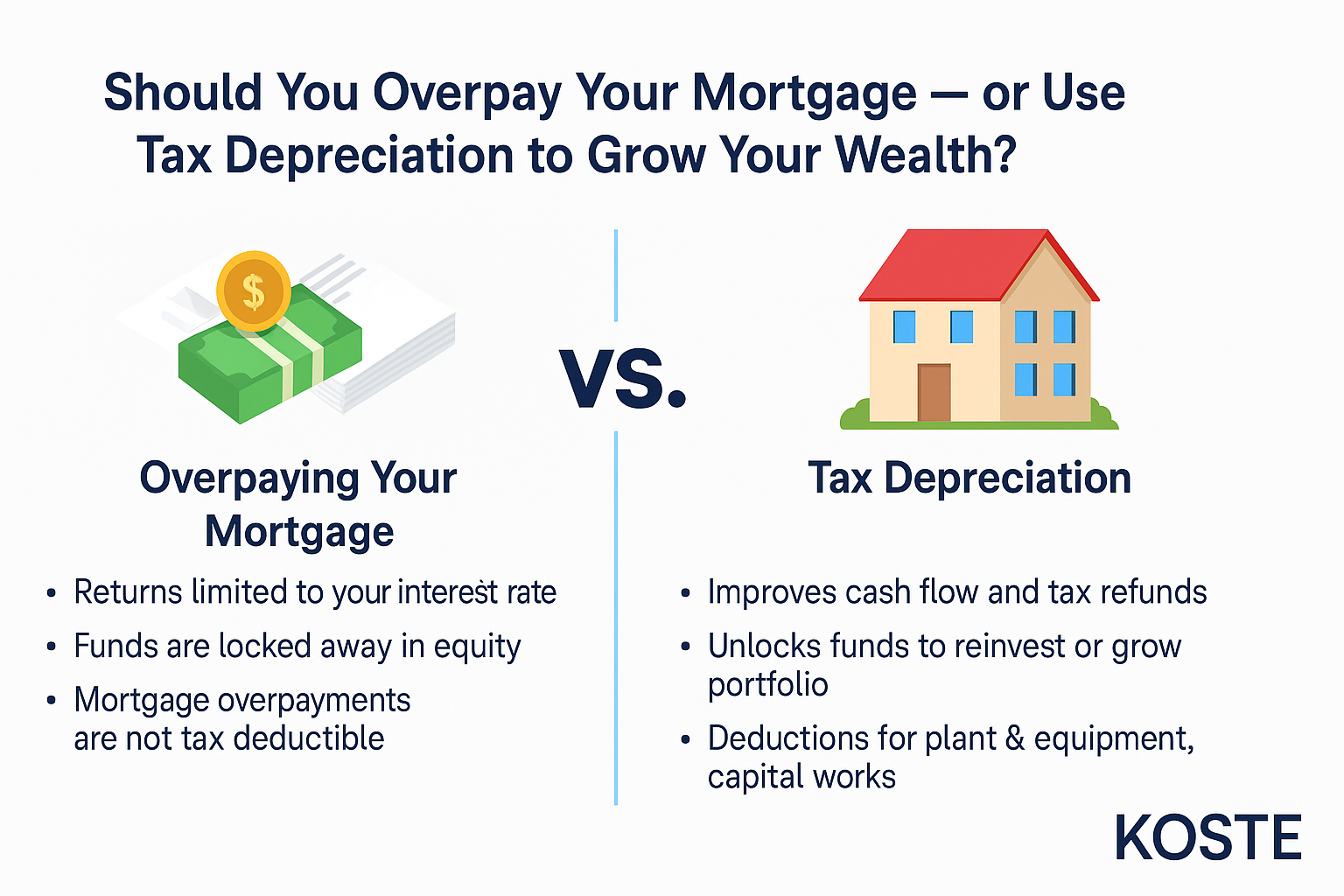
Maximise Tax Benefits for Landlords & Tenants | Koste
Lease incentives are a powerful tool used by landlords to attract tenants to their commercial properties. These incentives can range from rent-free periods to cash contributions for fit-outs, each carrying unique tax implications. Understanding how to navigate these incentives can significantly impact your financial outcomes, whether you are a landlord or a tenant. This guide aims to demystify lease incentives, highlight how they should be treated for tax purposes in Australia, and provide practical examples to help you make informed decisions.
Types of Lease Incentives and Tax Treatments
Rent-Free Periods
During a rent-free period, landlords allow tenants to occupy the property without paying rent for a specified time. While this seems straightforward, it’s essential to understand that no depreciation claims can be made by the landlord during this period. According to Section 8-1 of the Income Tax Assessment Act 1997 (ITAA 1997), the landlord cannot claim a tax deduction for the forgone rent.
Cash Incentives
Cash incentives involve landlords giving tenants cash payments as an inducement to sign a lease. These payments are considered assessable income for the tenant under Section 15-2 of the ITAA 1997, while landlords can deduct these payments under Section 8-1 of the ITAA 1997. Tenants should be aware that they cannot claim depreciation on the cash received; it’s treated purely as income.
Cash Reimbursements for Fit-Outs or Lessor Works
When landlords reimburse tenants for fit-out costs or other improvements, they retain ownership of these works. Landlords can claim depreciation on these improvements, as outlined in Division 40 of the ITAA 1997. Tenants, however, cannot claim depreciation on reimbursed amounts since they do not own the improvements.
Fit-Out Contributions
Fit-out contributions can be made by either the tenant or the landlord:
- Tenant Contributions – When tenants invest in fit-out works, they retain ownership and can claim depreciation on these assets over their useful life, as per Division 40 & 43 of the ITAA 1997.
- Landlord Contributions – If the landlord funds the fit-out, they retain ownership and can claim depreciation.
Lessor Works Paid for by Lessor
Any works paid for and owned by the landlord are eligible for depreciation claims by the landlord. Division 40 of the ITAA 1997 governs these claims, ensuring landlords can deduct the costs of improvements over time.
Reversionary Fit-Outs (Tenant Abandonment)
Reversionary fit-outs occur when tenants leave their fit-outs behind upon vacating the property. In this case, ownership of the fit-out reverts to the landlord, who can then claim depreciation. However, the landlord is typically only eligible to claim Division 43 depreciation, which is based on the written-down value rather than Division 40, as there is no cash basis for claiming the full cost.
If tenants remove their fit-outs, they retain ownership and continue to claim depreciation under Division 40 of the ITAA 1997.
Make Good Payments
When tenants make payments to landlords in lieu of performing make-good obligations, these payments are treated as income for the landlord, who can claim depreciation on the received amounts. However, it is crucial for both parties to understand the implications of make-good obligations and ensure they are clearly documented in the lease agreement to avoid future disputes.
Table: Lease Incentives and Tax Treatments
| Lease Incentive | Ownership | Depreciation Treatment | Relevant Legislation | Issues to Consider |
|---|---|---|---|---|
| Rent-Free Periods | Landlord | No depreciation claims during the period | Section 8-1 of the ITAA 1997 | Future rent increases should not compensate for rent-free periods |
| Cash Incentives | Tenant | Tenant: Assessable income; Landlord: Deductible expense | Section 15-2 and Section 8-1 of the ITAA 1997 | Clarify nature of payments to avoid GST issues |
| Cash Reimbursements for Fit-Out or Lessor Works | Landlord | Landlord claims depreciation | Division 40 of the ITAA 1997 | Ensure correct documentation for reimbursement |
| Fit-Out Contributions (Tenant) | Tenant | Tenant claims depreciation | Division 40 of the ITAA 1997 | Specify rights for tenant to remove fit-outs at lease end |
| Fit-Out Contributions (Landlord) | Landlord | Landlord claims depreciation | Division 40 of the ITAA 1997 | Ensure fit-out contributions are correctly classified |
| Lessor Works Paid for by Lessor | Landlord | Landlord claims depreciation | Division 40 of the ITAA 1997 | Ensure compliance with ATO guidelines |
| Reversionary Fit-Outs (Left Behind) | Landlord | Landlord claims depreciation post-vacation under Division 43, based on written-down value | Division 43 of the ITAA 1997 | Limited to written-down value; no full cost claim under Division 40 |
| Reversionary Fit-Outs (Removed) | Tenant | Tenant continues to claim depreciation | Division 40 of the ITAA 1997 | Must document removal process and depreciation continuation |
| Make Good Payments | Landlord | Landlord claims depreciation on payments in lieu of make good | Division 40 of the ITAA 1997 | Clearly document make-good obligations and ensure both parties understand their roles |
Practical Examples
Cash Incentive Scenario
Imagine a tenant receiving a $50,000 cash incentive to sign a lease. This $50,000 is treated as taxable income for the tenant, increasing their taxable earnings for the year. For the landlord, this payment is a deductible expense, reducing their taxable income. The tenant cannot claim depreciation on this incentive; it’s purely treated as income.
Fit-Out Contribution by Tenant
A tenant invests $100,000 in a fit-out for their leased space. The tenant owns these improvements and can claim depreciation on the fit-out costs over the useful life of the assets. Depreciation rates will vary based on whether Division 40 (plant and equipment) or Division 43 (capital works) applies, which depends on the nature of the fit-out.
Reversionary Fit-Out (Tenant Abandonment) Example
Consider a tenant who installs a $200,000 fit-out and leaves it behind after vacating the property. The landlord now owns the fit-out and can claim depreciation on Division 43 only, based on the written-down value. Since there is no cash basis for claiming the full cost under Division 40, the landlord’s claim is limited to the depreciated value of the fit-out, which recognises the remaining useful life of the asset.
Key Takeaways
Understanding lease incentives and their tax implications is crucial for both landlords and tenants. Properly handling these incentives can lead to significant tax benefits. Ensure that lease agreements clearly specify the ownership and tax treatment of all incentives to avoid disputes and ensure compliance with tax regulations. Consulting with a qualified tax professional or quantity surveyor can provide further guidance tailored to your specific circumstances.
Navigating the complexities of lease incentives and tax depreciation can be challenging, but with the right knowledge and professional advice, both landlords and tenants can maximise their financial outcomes and compliance. If you’re unsure about any aspect of lease incentives or tax treatments, reach out to a tax professional to ensure you’re making the most of your opportunities.
Maximise property tax depreciation
Get a Free Quote today
Koste are the leading providers of commercial Tax Depreciation reports. Whether you are a tenant completing a fit-out or landlord recently purchasing a property we can help.

